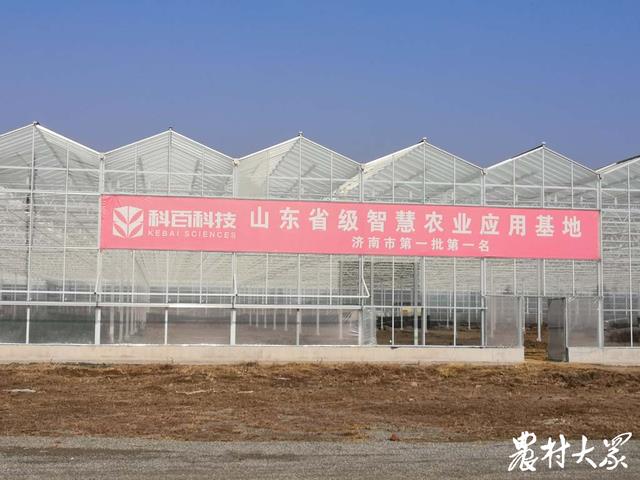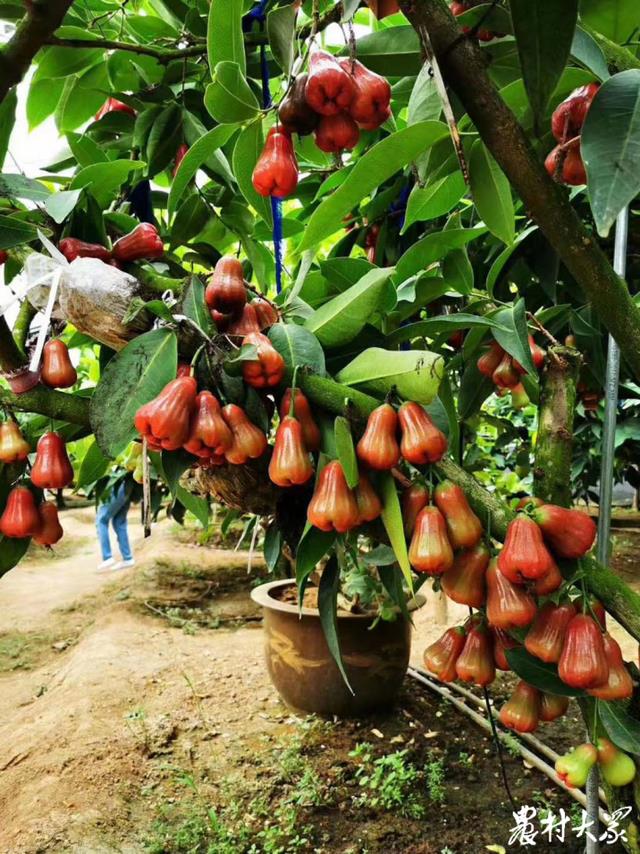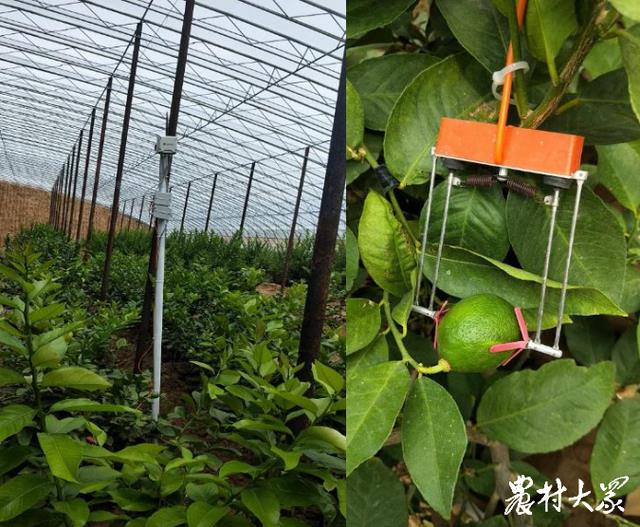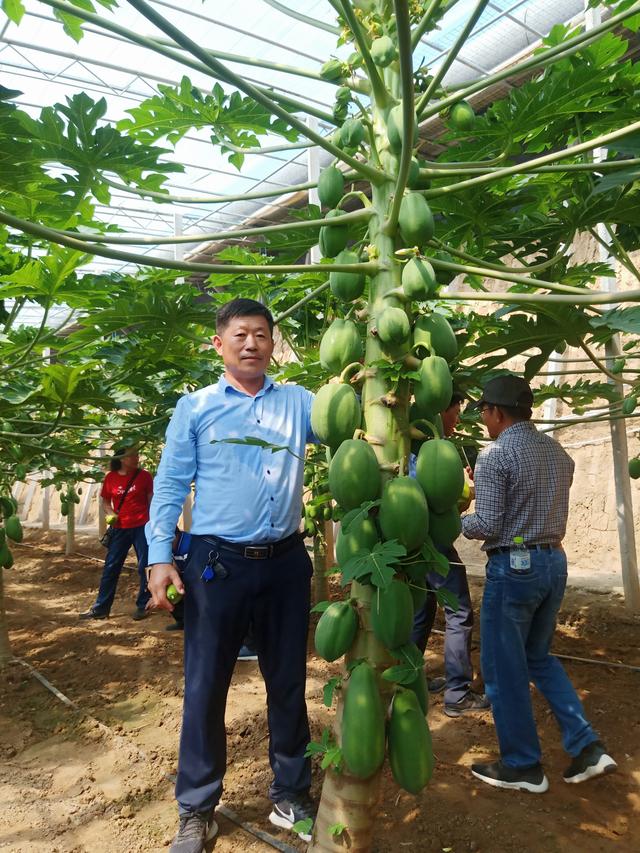
Kebai Technology’s newly built 30,000-square-meter large-scale intelligent multi-span glass greenhouse for Internet of Things.
Kebai Technology, located in Yangzhuang Town, Laiwu District, Jinan City, Shandong Province, is a smart agricultural company. They used smart agriculture to realize large-scale successful planting of various southern fruits in the north. A few days ago, the mass newspaper and rural mass reporters visited it and felt the shock brought by smart agriculture at close range.
Scientific research achievements have landed,
Jianqi wisdom industrial park
"Our park is a practical application exhibition base for the practical production of smart agriculture. The planned total investment of the park is 650 million yuan, and now it is mainly divided into two parts. Together, it is an agricultural big data center, and together it is a 20,000-mu precision and digital agricultural planting park. There are several types of new greenhouses here. Some are earth-back-wall greenhouses suitable for areas with low temperature or large temperature difference between day and night, some are new material greenhouses that can effectively save land space, and there are high-standard plexiglass greenhouses. It can basically represent the greenhouses needed by various geographical features in China. I will take you to the scene later. " On November 25, in the office of Jinan Kebai Smart Agriculture Industrial Park, Liu Xinyuan, the chief agronomist of the park, pointed to a row of greenhouses not far away and said with a smile.
Following the guidance of Liu Xinyuan, the reporter looked out, and the original thick and neatly arranged greenhouses were indeed different.
Liu Xinyuan introduced that although these greenhouses are different in materials and styles, they have one thing in common. They have all installed various agricultural Internet of Things detection and control equipment produced by Kebai, all of which use wireless detection, wireless transmission and wireless control to implement automatic management and operation of agricultural Internet of Things.
"To build these greenhouses with different styles, our purpose is to apply all kinds of high-tech data achievements in the laboratory to production, so that smart agriculture can blossom and bear fruit wherever it goes. Let the world have no crops that are difficult to grow. " Liu Xinyuan walked towards the greenhouse with the reporter and said confidently.
Smart agriculture helps,
South guoaishang north di
While speaking, Liu Xinyuan took the reporter into a common winter warm shed in the north. A damp and warm air came to my face, and the fruit trees in the shed were lush and shiny.

The expansion piece in Liu Xinyuan’s mobile phone is full of a tree of lotus mist, which is really gratifying to watch.
"This shed covers an area of 1.5 mu, and 68 red emerald lotus trees have been planted, all of which are seedlings from Guangdong. Although the planting range has moved to the north by 14 latitudes, we can accurately control the most suitable environment for the growth of lotus fog in the greenhouse by leveraging Kebai’s agricultural special Internet of Things automation management and agricultural big data cloud platform. It is better to ensure that the lotus leaves bear fruit many times a year, and the yield and quality are higher than those in the south. " Liu Xinyuan said that he opened the photo album of his mobile phone and opened a photo. I saw a lotus tree full of fruits, one by one like a red lantern is gratifying.
"You see, this is the tree in the photo. From March this year, the first crop of buds has been planted, and by the end of August, two crops have been planted, each with 40 to 50 kilograms. You sweep this, and all the information of this lotus mist can be seen. " Liu Xinyuan pointed to a small two-dimensional code card hanging on the tree.
Where did all this information come from?
Liu Xinyuan pointed out the detection and control facilities installed in several places in the greenhouse for the reporter to see.

The greenhouse is covered with various monitors to provide technical support for the growth of lotus fog.
It turns out that there are many secret weapons hidden in the greenhouse, which are the infrastructure of Kebai Agricultural Internet of Things and Agricultural Big Data Cloud Platform.
There are various clips on the leaves and stems of a lotus tree. Liu Xinyuan said that this is a sensor for monitoring plant growth, which can monitor leaf temperature and humidity, fruit diameter and stem growth in real time and interpret plant growth. Compare under what environment, plants grow fastest and fruits grow fastest. In addition, meteorological sensors are installed in the park to monitor air temperature and humidity, rainfall, wind speed and direction, carbon dioxide, etc. Soil and air sensors are also installed in the shed to obtain the real temperature, moisture, humidity, PH value and EC value of the soil and the air temperature and humidity.
The data collected by these sensors will be uploaded to the agricultural big data cloud platform through the wireless transmission system using the 5G base station. After analysis and calculation, a most suitable model for plant growth will be formed. Once this mode is determined, once there is a deviation between the real-time environment in the shed and the mode environment, the system will automatically give instructions to adjust the real-time environment to the best through measures such as ventilation, water spraying, watering and fertilization.
"It is with these guarantees that we can ensure the healthy growth of southern fruits in the north, and the yield per mu is higher than that in the south and the quality is good." Liu Xinyuan proudly said that there are 19 such sheds in their park, totaling 200 mu, plus a glass multi-span greenhouse that is not fully put into use and covers an area of 30,000 square meters. It only takes eight people to manage these.
I didn’t see the lotus mist hanging fruit, and the reporter and his party were a little lost. Liu Xinyuan invited us to see some more sheds. "I’ll show you the results of papaya and lemon in those sheds."

Liu Xinyuan told reporters that papaya grows from below, which is the photo of him and the first batch of papaya this year.
Walking into the papaya shed, everyone immediately got excited. I saw a papaya forest with fruitful results. The reporter roughly counted that an ordinary papaya here can bear hundreds of papaya, and the papaya here has three or four kilograms after maturity, and the output is amazing.
Liu Xinyuan introduced that in recent years, there has been a small upsurge of planting southern fruits in the north, but due to some objective factors, at present, many growers and parks can only introduce several common general southern fruits. However, with the help of smart agriculture and big data of the Internet of Things, Kebai Smart Park has successfully planted nearly ten kinds of southern characteristic fruits such as lotus, litchi, papaya, longan, lemon and sugarcane on a large scale.

The sugar cane planted in the park can be cut down, which is especially sweet.
Subvert traditional agriculture,
Make agricultural production lighter, simpler and more efficient
"Planting in the south and planting in the north must be a minority. Our goal is to apply smart agriculture to traditional agriculture, especially local leading industries, so that agricultural production is lighter, simpler and more efficient." Walking out of the south fruit and north planting greenhouse, Liu Xinyuan took us to a ginger field that was harvested soon.
Laiwu is a famous ginger producing area in China. This year, Liu Xinyuan led his team to apply smart agriculture to ginger production.
Outside this 3-acre open-air ginger field, there stands an iron guy, and the wind leaves on it are whirring. Cao Yaopeng, a big data agronomist in charge of digital planting management in the park, introduced that this is a scientific and technological equipment integrating weather stations and micro-base stations of the Internet of Things. Including the data in the Nanguo North Seed Greenhouse that I just visited, were uploaded through it.

This year, Liu Xinyuan led his team to apply smart agriculture to ginger production.
Walking into Jiangtian, I saw water and fertilizer integrated facilities on the ground, and more than ten wireless sensors were inserted in the soil. The air temperature and humidity, air pressure, carbon dioxide, water and fertilizer in Jiangtian will transmit data to the big data center through sensors. The system will automatically give instructions for watering, fertilizing and shading according to the most suitable growth parameters of ginger. If there are signs of pests and diseases, an early warning will be issued.
"Ginger is shade-tolerant, but it also needs plenty of light. The automatic sunshade net erected above Jiangtian will be automatically opened or closed according to the data comparison. " Cao Yaopeng said, "The whole process takes a short time, only about ten minutes, which is very convenient."
Said, Cao Yaopeng opened the mobile app to demonstrate the automatic opening and closing of the sunshade net for us. "When there are crops in the field, we don’t need human operation, and the sunshade net will automatically open and close according to data analysis. Now these 3 acres of ginger fields, except for sowing and harvesting, have all been automated. "
3 acres of ginger fields, what is the output?
"The average yield per mu is 12,500 Jin, which is 20% higher than that of traditional local planting. Moreover, according to the detection data of the Internet of Things, accurate management is carried out, and pests and diseases are prevented in advance according to the early warning, and the produced ginger is very safe. " The application of smart agriculture to ginger production was a great success for the first time, which made Liu Xinyuan look forward to helping more ginger farmers to simplify production in the future.
After the automatic control mode of ginger is determined, after the ginger farmers install relevant facilities in the ginger field, farmers only need to check the field environment at home and on their mobile phones, and combine the planting suggestions provided by the Agricultural Big Data Center to remotely control various agricultural equipment such as water and fertilizer irrigation and shading in the park. Ginger seeds can be easily planted.
It is noon to leave Kebai Technology. Looking back at the park, the newly built 30,000-square-meter large-scale intelligent multi-span glass greenhouse of the Internet of Things is shining, and the banner hanging on the external wall "Let there be no crops difficult to grow in the world" is particularly dazzling.
Mass Newspaper and Rural Mass Reporter Ji Feiyan
Reporting/feedback